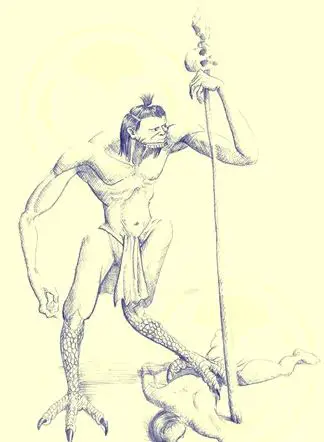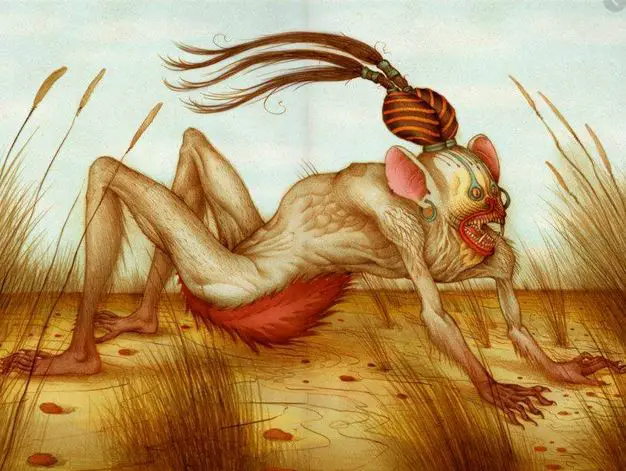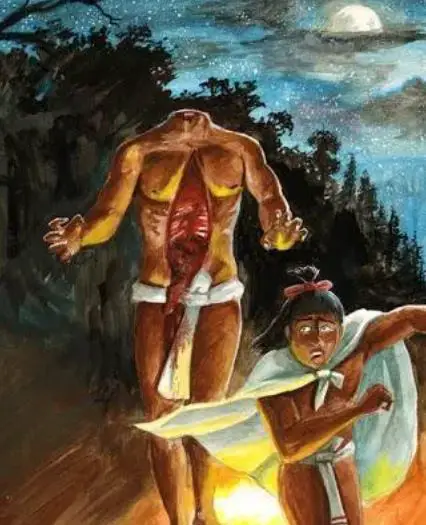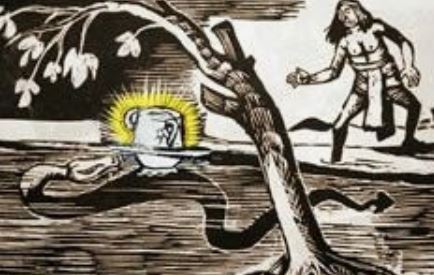Podcast: Play in new window | Download
Subscribe: Apple Podcasts | RSS
The Aztec Empire was a living and breathing political entity dominating central Mexico when Europeans first encountered it in 1519. Cortés and his band of Spanish conquistadors entered the Aztec capital of Tenochtitlán as invited guests of the Emperor Montezuma. They stayed in the capital for many months before things went south. This gave the Spanish much time to observe and document what they saw. These firsthand accounts are valuable to us today as we try to understand daily life among the Aztecs. Even after the Conquest Spanish clerics and scholars raced to document elements of a fading Aztec culture. As the Europeans and specifically the Church were interested in converting the massive population of natives to Christianity, they realized they needed at least a more than a basic understanding of the ancient Mexican religious beliefs and associated stories. Among these beliefs lurk many strange creatures and spirits and combinations of the two. Mexico Unexplained has explored some of these so-called “monsters” in previous shows. Links to shows about the more famous lake monsters, shape-shifting creatures and other bizarre animals are in the description. There are some other “monsters” that are not so well known with very little information about them surviving to the present day. Here are five of them.
- Oxkokoltzec
 In 1615, a Franciscan friar, Juan de Torquemada, published a book in Spain titled Monarquía Indiana, or in English, “Indian Monarchy.” The book was a monumental work chronicling the cultures and histories of many indigenous groups in New Spain. Torquemada was brought to New Spain from Spain as a child sometime in the 1560s and growing up in colonial Mexico he had interactions with natives who had experienced life before the Conquest. As Torquemada began ministering to the native peoples, he gathered stories of their religion and folklore. In his Indian Monarchy book, the friar mentions a curious monster that terrorized the pre-Aztec peoples in central Mexico and was feared for many decades after the Spanish took over. The Oxkokoltzec first appeared among the Toltecs during a festival. Many hundreds of people were dancing and then this terrible creature suddenly materialized out of thin air. He stood about 10 feet tall and was big and stocky, much like what we would have in our minds as the stereotypical “cave man.” He had a big forehead, long arms and he wore a loincloth around his midsection. When the Oxkokoltzec appeared and saw the dancers he smiled a big smile and decided to join in on the festivities. He danced with the Toltecs and enjoyed himself but because he was big and clumsy, his dancing turned into a horrible scene. Unknowingly, the giant seriously injured and even killed some people while swirling around. So as not to anger this creature, the officials in charge of the ceremonies continued with the music and dance until the great Oxkokoltzec had his fill of mirth and decided to disappear. The poor Toltecs were left with dozens of people dead. The scene allegedly occurred many times throughout history, from the time of the Toltecs to just a few generations before Juan de Torquemada wrote his book. Some folklorists and researchers on the more esoteric side have theorized that the happy, simple giant was a thought form or tulpa created by the revelers themselves or was manifested through a combination of music, dancing and singing that somehow brought the creature into this reality. There have been no reports of sightings of the Oxkokoltzec in modern times.
In 1615, a Franciscan friar, Juan de Torquemada, published a book in Spain titled Monarquía Indiana, or in English, “Indian Monarchy.” The book was a monumental work chronicling the cultures and histories of many indigenous groups in New Spain. Torquemada was brought to New Spain from Spain as a child sometime in the 1560s and growing up in colonial Mexico he had interactions with natives who had experienced life before the Conquest. As Torquemada began ministering to the native peoples, he gathered stories of their religion and folklore. In his Indian Monarchy book, the friar mentions a curious monster that terrorized the pre-Aztec peoples in central Mexico and was feared for many decades after the Spanish took over. The Oxkokoltzec first appeared among the Toltecs during a festival. Many hundreds of people were dancing and then this terrible creature suddenly materialized out of thin air. He stood about 10 feet tall and was big and stocky, much like what we would have in our minds as the stereotypical “cave man.” He had a big forehead, long arms and he wore a loincloth around his midsection. When the Oxkokoltzec appeared and saw the dancers he smiled a big smile and decided to join in on the festivities. He danced with the Toltecs and enjoyed himself but because he was big and clumsy, his dancing turned into a horrible scene. Unknowingly, the giant seriously injured and even killed some people while swirling around. So as not to anger this creature, the officials in charge of the ceremonies continued with the music and dance until the great Oxkokoltzec had his fill of mirth and decided to disappear. The poor Toltecs were left with dozens of people dead. The scene allegedly occurred many times throughout history, from the time of the Toltecs to just a few generations before Juan de Torquemada wrote his book. Some folklorists and researchers on the more esoteric side have theorized that the happy, simple giant was a thought form or tulpa created by the revelers themselves or was manifested through a combination of music, dancing and singing that somehow brought the creature into this reality. There have been no reports of sightings of the Oxkokoltzec in modern times.
- Tlacanexquimilli
Sometimes a thick fog would form over Lake Texcoco, the body of water that completely surrounded the Aztec capital of Tenochtitlán. When the city was engulfed in this thick fog, the residents stayed inside their homes for fear of an apparition called the Tlacanexquimilli. This “monster” was described in early Spanish accounts as a ghost. It sometimes had no legs and dragged itself through the imperial capital by its strong forearms. Some reports say that its head was a small human skull, almost like a shrunken head, with sharp teeth. A drawing from Spanish colonial times made a few decades after the Conquest shows just the Tlacanexquimilli’s torso with a neck surrounded with feathers and skinny arms with claws. A simple skull serves as its head. According to the legend, the creature would moan like a sick man and its cries could be heard for many miles. Some believed that the Tlacanexquimilli was a  creation of the Aztec god Tezcatlipoca, the Smoking Mirror God, the ruler of the night sky and keeper of the ancestral memories, the eternal rival of the great Quetzalcoatl. Tezcatlipoca sent the Tlacanexquimilli to earth to remind humans of their mortality. In the old chronicles even Emperor Montezuma was afraid of this ghostlike creature. According to tradition, whenever anyone heard the sick cries of this evil phantom, old soldiers would be the only ones allowed to confront it, usually before it got a chance to get to the heart of the city. The old soldiers would try to talk to the Tlacanexquimilli and reason with it. The creature would offer the soldiers things they would not want – such as a fistful of cactus spines – and the rejection of its generosity would usually cause the Tlacanexquimilli to retreat, discouraged and sad. While not as menacing as many of the other supernatural creatures of the Aztecs, the Tlacanexquimilli usually was a bad omen and came right before a war or a plague.
creation of the Aztec god Tezcatlipoca, the Smoking Mirror God, the ruler of the night sky and keeper of the ancestral memories, the eternal rival of the great Quetzalcoatl. Tezcatlipoca sent the Tlacanexquimilli to earth to remind humans of their mortality. In the old chronicles even Emperor Montezuma was afraid of this ghostlike creature. According to tradition, whenever anyone heard the sick cries of this evil phantom, old soldiers would be the only ones allowed to confront it, usually before it got a chance to get to the heart of the city. The old soldiers would try to talk to the Tlacanexquimilli and reason with it. The creature would offer the soldiers things they would not want – such as a fistful of cactus spines – and the rejection of its generosity would usually cause the Tlacanexquimilli to retreat, discouraged and sad. While not as menacing as many of the other supernatural creatures of the Aztecs, the Tlacanexquimilli usually was a bad omen and came right before a war or a plague.
3. Yoaltepuztli
This creature lived in the dense forests and could be found throughout the Aztec Empire. It was humanoid and slightly larger than the average man. He was headless and in some accounts he was known to carry his head around by the hair. People went to the forests to search for the Yoaltepuztli because according to legend, if you were brave enough to seek him out and meet with him, he would consider granting you wishes. Many would try to commune with this creature to try to obtain money or a military victory. The headless  Yoaltepuztli would make a loud cracking sound, like a tree falling in the forest. From this sound came the creature’s nickname, “The Night Axe.” The sound came from the Yoaltepuztli opening up his chest when he sensed humans nearby. Like the Tlacanexquimilli, this Aztec monster would offer humans it encountered cactus thorns. If he sensed great bravery among his human visitor, he would give that person more thorns. If the Yoaltepuztli was in a bad mood or didn’t wish to be disturbed by humans, sometimes he would strike down his visitors and curse them with poverty and misery. In one tale, a Spanish chronicler stated that if a human visitor could tear out the heart of the Yoaltepuztli from its already opened up torso, this led to a whole other series of fortunes and misfortunes. If you could keep the creature away from its heart for one day, the lucky – or unlucky – human would get to see the heart transform itself. If the heart turned into a ball of feathers the next day the human would be prosperous and lucky throughout his life. If the heart turned into a black blob, the human would be forever cursed.
Yoaltepuztli would make a loud cracking sound, like a tree falling in the forest. From this sound came the creature’s nickname, “The Night Axe.” The sound came from the Yoaltepuztli opening up his chest when he sensed humans nearby. Like the Tlacanexquimilli, this Aztec monster would offer humans it encountered cactus thorns. If he sensed great bravery among his human visitor, he would give that person more thorns. If the Yoaltepuztli was in a bad mood or didn’t wish to be disturbed by humans, sometimes he would strike down his visitors and curse them with poverty and misery. In one tale, a Spanish chronicler stated that if a human visitor could tear out the heart of the Yoaltepuztli from its already opened up torso, this led to a whole other series of fortunes and misfortunes. If you could keep the creature away from its heart for one day, the lucky – or unlucky – human would get to see the heart transform itself. If the heart turned into a ball of feathers the next day the human would be prosperous and lucky throughout his life. If the heart turned into a black blob, the human would be forever cursed.
4.Ixpuxtequi
The Spanish considered the Ixpuxtequi a horrible demon and a possible manifestation of Satan himself. He was humanoid, tall and lean but muscular, with bird legs that went up to his knees. He carried a long staff to lean on. That staff usually had a human skull or two attached to it for ornamentation. Sometimes Ixpuxtequi was described as having long and sharp claws. To the Aztecs he hailed from Mictlan, the underworld where souls traveled to after death, and was considered a lord there. He was married to a minor Aztec deity called Nexoxcho, who was the goddess of fear. Nexoxcho’s brother, the brother-in-law of Ixpuxtequi, was Xoaltentli, the god of sleep disorders and mental illnesses. While in Mictlan, Ixpuxtequi kept the interesting company of his extended family but sometimes he became restless. While his wife, the beautiful fear goddess, never left the underworld, occasionally Ixpuxtequi would come to the surface of the earth and would randomly curse humans, especially night travelers. He would stalk the long-distance trade routes of the Aztec Empire looking for his prey and would occasionally frequent the streets and alleyways of some of the major cities of ancient Mexico such as Tenochtitlán, Tlacopan and Texcoco. Unlike other Aztec monsters, one could not reason with the Ixpuxtequi. If you saw him, it meant certain doom and maybe even death, and there was no possibility to negotiate with him.
- Xicalcoatl
The name of this creature in the Aztec language Nahuatl literally means, “chocolate cup snake.” After the Conquest, the name was Hispanicized to “jicalcoate,” and for many years it was believed to be a real animal but unclassified, also known as a cryptid. The Xicalcoatl was a large water snake that inhabited Lake Texcoco and the surrounding waterways. It was primarily black in color with  a variety of tones, mostly pale green and yellow, on its underbelly. This unusual snake got its name from the strange shape that grew out of its back when it reached maturity. The growth was said to resemble a chocolate cup or some other small ceramic vessel. In some legends, this protrusion was often decorated like a piece of pottery. The Xicalcoatl would use this growth on its back as a sort of decoy. It would go to the shallow areas of the water in places where it knew humans would frequent. The snake would then submerge itself so the strange pottery-looking shape on its back was exposed to the surface. Humans would see that “chocolate cup” and wade out into the water to try to take it away. As the human drew closer, the snake would move away more to try to get the unsuspecting person into deeper water. When the Xicalcoatl had lured the human to a distance sufficiently far from the shore, it would churn the water and cause the human to drown. The human would never be heard from again. While this version of the story of the Xicalcoatl comes directly from the writings of a Spanish colonist a few years after the conquest, a similar urban legend exists in Mexico today which may have direct ties centuries back to the original legend of the Xicalcoatl. In the modern story, an evil fairy leaves little chocolate cups in the water to tempt unsuspecting children. As with the gigantic snake story, the cups serve as decoys to get the children into the water in order to drown them. Some wonder if the story of Xicalcoatl could be based on the existence of a real creature, a possibly now-extinct water snake that only lived in Lake Texcoco before it was drained by Spanish civil engineers acting under royal authority. With the draining of the lake and the expansion of Mexico City into its territory, perhaps this strange water snake really did exist and died off from loss of habitat. Although no physical remains have yet been found, the possibility that the Xicalcoatl was once a real creature is still on the table for some cryptozoologists, those who investigate and seek to identify legendary animals.
a variety of tones, mostly pale green and yellow, on its underbelly. This unusual snake got its name from the strange shape that grew out of its back when it reached maturity. The growth was said to resemble a chocolate cup or some other small ceramic vessel. In some legends, this protrusion was often decorated like a piece of pottery. The Xicalcoatl would use this growth on its back as a sort of decoy. It would go to the shallow areas of the water in places where it knew humans would frequent. The snake would then submerge itself so the strange pottery-looking shape on its back was exposed to the surface. Humans would see that “chocolate cup” and wade out into the water to try to take it away. As the human drew closer, the snake would move away more to try to get the unsuspecting person into deeper water. When the Xicalcoatl had lured the human to a distance sufficiently far from the shore, it would churn the water and cause the human to drown. The human would never be heard from again. While this version of the story of the Xicalcoatl comes directly from the writings of a Spanish colonist a few years after the conquest, a similar urban legend exists in Mexico today which may have direct ties centuries back to the original legend of the Xicalcoatl. In the modern story, an evil fairy leaves little chocolate cups in the water to tempt unsuspecting children. As with the gigantic snake story, the cups serve as decoys to get the children into the water in order to drown them. Some wonder if the story of Xicalcoatl could be based on the existence of a real creature, a possibly now-extinct water snake that only lived in Lake Texcoco before it was drained by Spanish civil engineers acting under royal authority. With the draining of the lake and the expansion of Mexico City into its territory, perhaps this strange water snake really did exist and died off from loss of habitat. Although no physical remains have yet been found, the possibility that the Xicalcoatl was once a real creature is still on the table for some cryptozoologists, those who investigate and seek to identify legendary animals.
REFERENCES
Cecilio Agustín Robelo Porrua Library, ed. Dictionary of Nahua Mythology, Mexico . Mexico: Printing of the National Museum of Archeology, History and Ethnology, 1905.
Gonzalez Casanova, Pablo. Nahuatl Stories: Indigenous Tales From Mexico. Wellington, NZ: Victoria University Press, 2013. We are Amazon affiliates. Buy the book on Amazon here: https://amzn.to/3ctCbdy
Nuttall, Z. A Note on Ancient Mexican Folk-lore. The Journal of American Folklore, v. 8, no. 29, pp. 117-129, 1895.
Sahagun, Bernardo Historia General de las Cosas de Nueva España, v. III. Alejandro Valdés, Calle de Santo Domingo, Esquina de Tacuba, Mexico, 1830.
